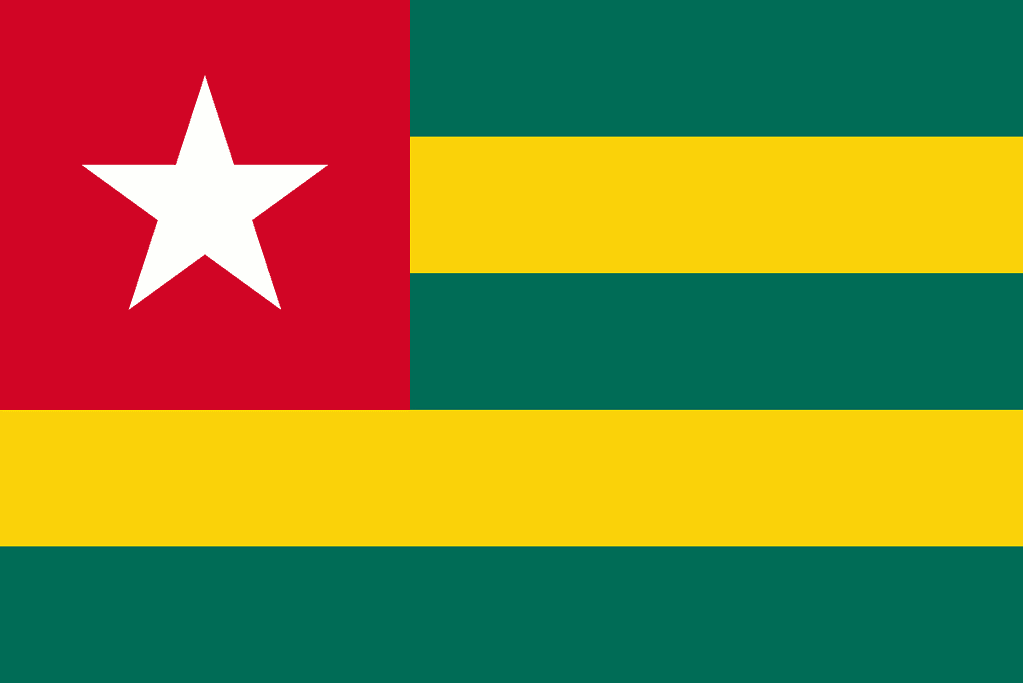What do you think of when you see a flag? Many likely think they are nothing more than a brightly coloured distinguishing mark of a country or state. While that is completely true, flags are actually much more than that alone. This is because they can be used to symbolise things such as war, history, peace, or hope. In many cases even the colors used on the flag can be highly symbolic. Then there’s the variety of shapes, images, writing that flags can bear — all of which tell a story. So, what does the flag of Togo represent? Let’s discover its history and exactly what it means. We’ll also learn about the former flags of Togo.
About Togo
Togo, officially called the Togolese Republic, is a West African country bordered by Benin, Burkina Faso, and Ghana. Togo is a small country, and although it covers 22,000 square miles, it is only 99 miles wide at its broadest point. However, despite its small size, Togo is incredibly diverse and features mountains, plateaus, tablelands, rivers, and forests. Togo’s southern region forms part of the Guinean forest-savanna mosaic ecoregion, a band of forests, grasslands, and savannas.
In 1884, Germany claimed a protectorate over a stretch of land near the coast. Germany gradually extended its control inland until it officially became the German colony of Togoland. Both Britain and France then invaded Togoland during the First World War. Following the defeat of the German forces, Togoland was partitioned, forming British Togoland in the west and French Togoland in the east.
In 1957, British Togoland voted to join the Gold Coast (a British colony) and subsequently became part of the newly independent Ghana, with most forming part of its modern-day Volta region. In 1960, Togo severed its ties with France and became an independent nation. Therefore, the land that once formed French Togoland makes up the country of Togo as we know it today.
History of the Flag of Togo

Including Togo, there are currently ten national flags in the stars and stripes family.
©SKopp | CC BY-SA – License
The current flag of Togo was designed by artist Paul Ahyi and adopted in 1960. It features five alternating horizontal bands of green and yellow. It also features a red square with a white five-pointed star in the canton. Due to the use of alternating stripes and an emblem in the canton, the flag of Togo forms part of the stars and stripes flag family. Including Togo, there are currently ten national flags in the stars and stripes family — the best known of which is the U.S. flag. The family’s other flags are Abkhazia, Chile, Cuba, Greece, Liberia, Malaysia, Uruguay, and Puerto Rico.
After British Togoland voted to become part of Ghana, French Togoland eventually became an autonomous republic of France in 1959, with France still controlling the nation’s finances, defense, and foreign relations. However, the Togolese Republic was announced on April 27. 1960 and the new flag was adopted just a day later.
Symbolism and Meaning
Symbolism can be attached to most parts of the flag of Togo, but first, we’ll begin with the horizontal stripes. Five stripes represent the five regions of Togo — Centrale, Kara, Maritime, Plateaux, and Savanes. Next, we’ll move on to the white star representing hope and purity. The canton, as a whole, symbolizes charity, fidelity, and love.
Four colors are used on the flag, including the white of the star. The red, yellow, and green are Pan-African colors derived from the flag of Ethiopia and collectively symbolize liberty and independence. Red represents the blood shed in the fight for freedom. Green symbolizes the fertile land of Africa. It also reminds us that most of Togo’s population relies on the land for survival. Yellow represents the natural mineral resources in the country and how it has toiled with only its labor to develop it.
Former Flags of Togo
Togo has four flags that have flown over it in the past 150 years. The first was the flag of Togoland between 1884 and 1916. The flag used was the black, white, and red tricolor of the German Empire, as Togoland was a German protectorate.
Following the invasion of France and Britain, the following flag in use was the French tricolor from 1916, representing French Togoland until 1955 and then the Autonomous Republic of Togo until 1957. In 1957 a completely new flag was designed for Togo, which consisted of a green field with the French tricolor in the canton. It also had two five-pointed white stars — one in the upper fly corner and one in the lower hoist corner. The green field is said to have symbolized agriculture, youth, and hope. The arrangement of the stars represented the savannas in the north and the southern coastal plain which were “united in both love and order.” However, another interpretation is that they represented British and French Togoland.
The French flag was removed from the design the following year. The resulting flag remained in use until 1960, when the current design was adopted.
Up Next
- Every Flag in the World: Photos, History, and More
- The Flag of Ghana: History, Meaning, and Symbolism
- The Flag of Benin: History, Meaning, and Symbolism
The photo featured at the top of this post is © Nicolas Raymond | CC BY – License / Original
Thank you for reading! Have some feedback for us? Contact the AZ Animals editorial team.






